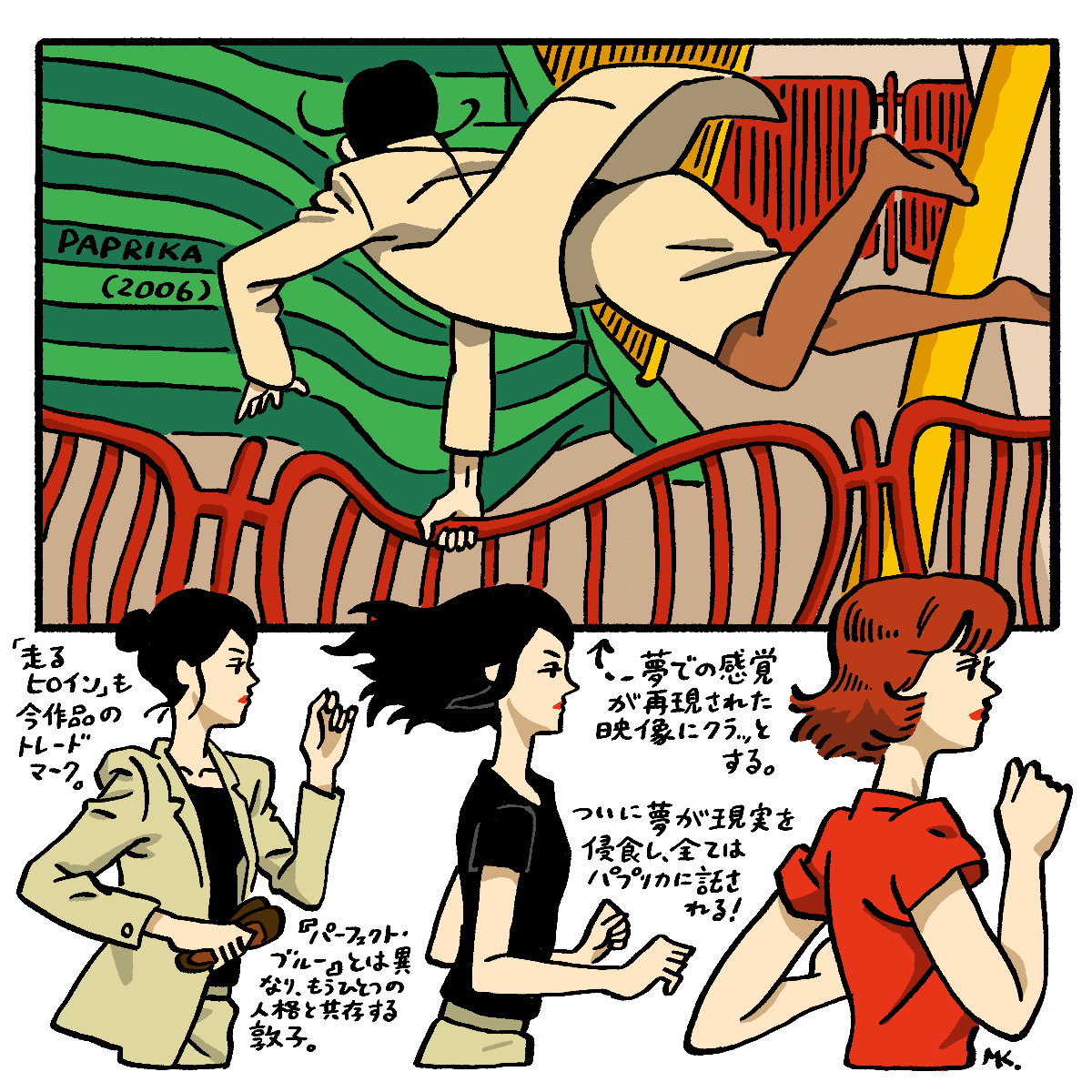![Satoshi Kon's work where fiction and reality intermingle [Mizumaru Kawahara's CINEMONOLOGUE Vol.61]](https://cinemore.jp/images/0d8638030074baca01d26bb54cebaab45352041a5c317ac77badd9505f8fbe2e.png)
Satoshi Kon's work where fiction and reality intermingle [Mizumaru Kawahara's CINEMONOLOGUE Vol.61]
``Paprika'' where dreams invade reality

In contrast to movies, which are artificial fictions, the theme of `` Paprika' ' is dreams, which are primordial human fictions. Atsuko Chiba, a psychotherapist who works at the National Institute of Psychiatry, uses the "DC Mini", a device developed by the genius scientist Kosaku Tokita that allows her to enter other people's dreams, to enter patients' dreams as "Paprika" with a different appearance and personality. He was also a dream detective who appeared and investigated the cause of the nightmares. It is also interesting to note that the theme of another self, which was portrayed fearfully in `` Perfect Blue ,'' is developed here as a positive driving force for the story, and an innocent heroine. Paprika's figure appears when Atsuko's figure is reflected in a glass, etc., and it reminds me of the scene in ``Perfect Blue'' where Mima's figure reflected in a train window or mirror changes into the idol Mima. However, Atsuko is able to converse with Paprika, who appears as a virtual image, and can switch herself into Paprika at will, allowing her to coexist to some extent with her second personality.
The story begins when a key device, the DC Mini, is stolen from a laboratory. Since the DC Mini can be used to interfere with other people's dreams, if it is misused, a terrible terrorist attack will occur. In fact, at the research institute, some victims are mentally attacked by nightmares, and Atsuko and her friends run from dream to dream in pursuit of the culprit.
The characters in this work have become even more appealing, but the feeling of scenery that at first glance appeared to be reality disintegrating into a dream is strangely real. In other words, the feeling in the dream is well reproduced, but especially at the moment when Atsuko tries to climb over an ordinary fence, the scenery including the fence begins to distort, and it turns out that the fence is actually the fence on the balcony of the upper floor of the apartment. The scene where it is revealed that he was trying to overcome something often evokes the terrifying feeling of falling in a dream. Or, when the troubled detective Konakawa, who Paprika undertakes to treat, runs after the ``culprit'' in his own nightmare, the floor of the hallway ripples and he is unable to move forward as expected. It reminds me of the feeling you get when your body doesn't move the way you want it to (it's also famous for having a scene similar to Christopher Nolan's Inception ).
Being able to interfere with other people's dreams, DC Mini's rampage eventually extends to the real world of dreams. The chaotic and incoherent parade that existed in dreams appears on real roads, people's faces and bodies transform, and destruction occurs in the real cityscape. Finally, even Paprika appears in front of Atsuko in a physical form, and the two sprint together to defeat the mastermind. Until now, ``Perfect Blue'' has depicted the blurring of the boundaries between delusion and reality, and `` Millennium Actress '' has depicted how the boundaries between movies (memories) and reality have become blurred, but in ``Paprika,'' dreams finally become reality. It erodes and the two become one. As an agent of two worlds, Paprika is an iconic character.
In the words of Inspector Konakawa, Paprika is also a movie actress in her dreams. All three of the films mentioned here have a heroine who is an actress in common, and the movie is also an important element. The many nightmares brought about by the regrets of Inspector Konakawa, who aspired to make movies but gave up on them, are all depicted as movies starring Konakawa himself, but at the same time movies are artificial fictions, they are also artificial dreams. It might be. Considering this, Chiyoko's fusion of film and reality in ``Millennium Actress'' may also be a manifestation of Chiyoko's wishes and dreams.
It is also significant that animation is the medium used to depict these stories of fiction and reality. As I wrote at the beginning, the outline of the story is also an illusion called anime, and the real pleasure and charm of Satoshi Kon's works lies in the fact that it becomes ambiguous as to which of the many overlapping layers is real in the story. Probably one. Mima, Chiyoko, and Paprika Moko can truly be said to be the leading actresses of these works.
A work by director Satoshi Kon that I really wanted to see more of. However, although there are not many of them, each one of them is valuable and irreplaceable. I feel very fortunate to have encountered works that have changed the way I view not only animation, but also paintings, and even reality.
Illustrations and text: Mizumaru Kawahara
Born in 1991. Illustrator. In addition to illustrations and covers for magazines and books, there are also illustration columns for movies and books. New movie reviews are currently being serialized in "SPUR" (Shueisha).

